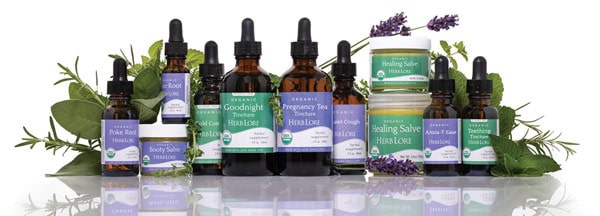The non-alcohol version of our tinctures are recommended for children.
The charts and suggestions below may be used in determining the appropriate amount of herbal remedy to give to children.
Please keep in mind, however, that these are just guidelines. The weight and overall health of the child must be taken into consideration, as well as the strength and quality of the herbs to be given, along with the nature of the child’s illness.
Herbs and herbal products should not be given to babies under 6 months of age, as their digestive systems are not mature enough to handle much more than breastmilk (or formula if its necessary).
To give herbs to an infant, it’s best for the breastfeeding mother to take full adult dose of the herb (see the Note: below) and it will pass to the baby through the breastmilk.
If a baby is in acute distress, such as from gas or colic, or if the baby is not breastfed, a small amount of non-alcohol tincture or diluted tea can be given directly to the baby on an occasional basis. Babies over 6 months of age can be given the herbs directly, but as each child is different, if they experience any kind of tummy ache or distress, please discontinue.
Always give babies and children the non-alcohol versions if possible, and if not possible, dilute the tincture in breastmilk (or formula), juice or water to administer.
Do NOT allow them to suck on the dropper or touch it to their mouth! They will want to, so be prepared! That’s what babies do! The tube is made of glass and can break if bitten hard enough, and it may also contaminate the tincture and potentially cause mold to grow in the product. Mold is a white or greyish blob that you can see floating on top of the liquid or attached to the glass dropper tube. If it has been contaminated, please discard the product and do not use or give to your child.
The chart below will give you recommendations of how much to give to a baby or child.
NOTE:
– A typical adult dose is 1 cup (8 oz.) of tea, and two droppersful (or squeezes, which is 60 drops) of tincture each dose. The information below is based on this information.
– Follow the dosage recommendations on the product label as far as the frequency, or how many times a day the herbs should be given, using the dosage amounts given below. For example, if an adult dose is 1 cup of tea or 2 droppersful of tincture 3 times a day, the recommended dose for a 2 year old would be 2 teaspoons of tea or 10 drops of tincture 3 times a day.
TEAS:
When the adult (age 12 and over) dose is 1 cup (8 oz.) of tea, the following is recommended for children:
Age — Dosage
Younger than 2 years — 1/2 to 1 teaspoon
2 to 4 years — 2 teaspoons
4 to 7 years — 1 tablespoon
7 to 11 years — 2 tablespoons
TINCTURES:
When the adult dose is 2 droppersful (60 drops), the following is recommended for children:
Age — Dosage
Younger than 3 months — 2 drops
3 to 6 months — 3 drops
6 to 9 months — 4 drops
9 to 12 months — 5 drops
12 to 18 months — 7 drops
18 to 24 months — 8 drops
2 to 3 years — 10 drops
3 to 4 years — 12 drops
4 to 6 years — 15 drops
6 to 9 years — 24 drops
9 to 12 years — 30 drops
Other ways to determine dosage:
Young’s Rule – Add 12 to the child’s age. Divide the child’s age by this total. Example: dosage for a 4 year old: 4 divided by 16 (4+12) = .25, or 1/4 of the adult dosage.
Cowling’s Rule – Divide the number of the child’s next birthday by 24. Example: dosage for a child who is 3, turning 4 would be: 4 divided by 24 = .16, or 1/6 of the adult dosage.
Reference used: “Herbal Remedies for Children’s Health” by Rosemary Gladstar
Related Articles (open for public viewing)
written by Pam Caldwell
Certified Herbalist — Fertility, Pregnancy, Birth, Postpartum & Lactation Specialist

